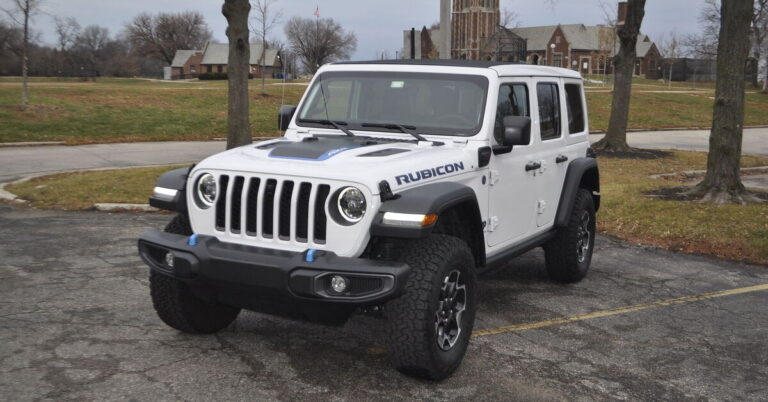I spent the past few days behind the wheel of a 2023 Jeep Wrangler Rubicon 4xe.
Notes? Oh, I have notes.
The 4xe pairs a 2.0-liter turbocharged four-cylinder that makes 270 horsepower and 295 lb-ft of torque with a starter/generator motor and a transmission traction motor for a total system power output of 375 horsepower and 470 lb-ft of torque. The automatic transmission has eight speeds.
Some quick thoughts:
- The 4xe may have neat tech, but you still make all the usual tradeoffs you do with Wranglers, especially a Rubicon. That means a lot of noise — especially with the power soft-top and the 33-inch off-road tires.
- Occasionally the transition when the gas engine kicks on is a bit trashy and jarring.
- Adventures in charging continue. I had no problem getting juice from one outlet in my building — 94 percent in about 12 hours — but for some reason, another outlet in my building caused an error message to pop up on the dash. The message just said the system detected an error, or something like that, so I couldn’t tell what was wrong. At least storing the charger is easy, as is plugging in/unplugging. And hey, since it has a gas engine, a failure to charge isn’t an emergency.
- I had no time to go off-road, but I’d love to have spent a day wheelin’ with that torque available — and in silence, if I had the chance to charge the battery beforehand. Which I might’ve — the park I’ve used the most often appears to have a Jeep-branded charging setup at its entrance.
- The torque is helpful around town, unsurprisingly.
- UConnect remains great.
- The tires struggled a bit with slightly wet streets — I slid, just a tiny bit at low speeds, when approaching a stop during wet weather. Nothing scary or uncontrollable. It’s just that these tires are meant for mud, sand, or rocks — not rain-slicked streets. The easy fix was slowing down a tad and braking earlier and more gently.
- I always feel like I am more engaged with driving when behind the wheel of a Wrangler, especially one with off-road rubber, because one has to pay more attention to the steering to keep it on track. It needs more constant adjusting, even during highway cruising, than almost any vehicle on the road. Even Ford’s Bronco, the closest competitor, requires less effort to keep it on the straight and narrow.
- Rear-seat room is tight, but I could fit back there. I just wouldn’t want to hang out there for a long trip.
- The e-save mode is nice but I hardly used it.
- Even with the hybrid, fuel economy (at least in urban driving) isn’t great. I was seeing just under 20 mpg. The window sticker suggests that in gas-only mode, one should get 20 mpg combined. Combined city/highway MPGe is 49.
- For the record, the one trip I did on full charge, at 94 percent, got me 22 miles. I started out in urban driving, then in stop and go freeway traffic, and finally the battery ran out of juice and switched over to the gas engine right after traffic opened up.
Final thoughts: A PHEV Wrangler has some advantages over the ICE versions, but fuel economy still won’t be great unless you can charge reliably overnight, and you still make all the usual Wrangler tradeoffs, especially in Rubicon guise. Oh, and the price is eye-popping at $69,385. The soft-top is a big part of that, it and some associated features cost over $4K. The base price, if you’re wondering, is a still dear $58,595. Oof.
[Image © 2022 Tim Healey/TTAC]
Become a TTAC insider. Get the latest news, features, TTAC takes, and everything else that gets to the truth about cars first by subscribing to our newsletter.


